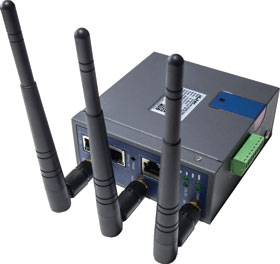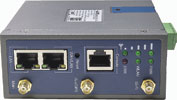

In the final quarter of 2014, Otto Wireless Solutions introduced Shenzhen-based industrial telecoms manufacturer, Wlink Technology, to the South African market to address the growing needs of applications requiring reliable industrial mobile connectivity.
“Wlink’s balance of quality manufacturing and a highly experienced R&D team allow it to develop products that are highly reliable while remaining affordable, a combination that has proved popular in the local market,” says Otto’s Stephen de Ujfalussy.
Since the introduction of the first Wlink device, the portfolio has grown to include a range of industrial modems and routers offering various combinations of features, including support for LTE, HSPA, Wi-Fi, GPS, Dual-SIM and RS-232.
“The extensive range of router models accommodates the flexibility which consumers often want as they no longer need to purchase a router with features that are extraneous to the application requirements, which unnecessarily drives up the price of such a device,” de Ujfalussy says. “The range of routers also lends itself to the scalability of an application. Subsystems of an application may have different requirements, for example some sites requiring multiple LAN connections and others requiring no LAN but needing Wi-Fi instead.
Now, the WL-R200 and WL-R520, with their single and quad Ethernet ports respectively, are set to be joined by the imminent introduction of the WL-R210 series. The WL-R210 has the added benefit of offering three input/ output ports, two of which can be configured as inputs and the third as an output.
The input ports can be configured to signal an alarm event either when the status is low, when the status is high, or when a pulse counter has reached the preset count trigger. When an alarm event occurs, up to two phone numbers can be preset to have SMSs sent to them, or the output port can be triggered. The output port can alternatively be triggered through the receipt of an SMS.
“Users can program two numbers and an SMS trigger content which would enable only an SMS arriving on the router’s SIM card from one of those two numbers with the specified SMS content in the message, to be able to trigger the output port,“ explains De Ujfalussy. “Two additional numbers can be programmed on the router to enable an SMS to be sent to notify those numbers after the output port has been triggered.”
The output signal can either be in the form of open from ground, shorted to ground, or a square wave pulse. In the case of the pulse signal, the square wave duty cycle can be configured through basic controls addressing the time delay, the time for which the wave is low and the time for which the wave is high.

The full series of Wlink industrial routers supports the most commonly used software features present in networking today. These include basic controls such as DHCP, DDNS, WLAN, NTP, SNMP as well as more advanced functionalities such as port forwarding, fire-walling, Serial App, VPN and remote management. Whereas some of these features may be common across a variety of router brands, Wlink distinguishes itself through the implementation of cellular connectivity and free backend management features, a common platform used for remote management and monitoring of all its router models.
When the connection method is set to ‘keep alive’ the router will automatically establish an Internet connection when powered on with a SIM card inserted and antenna connected. If a connection cannot be established, the router will reboot itself so as to reattempt the Internet dial-up.
In the case of a Dual SIM model, the router would automatically switch to the secondary SIM card to try to establish an Internet connection. This feature lends itself particularly well to mobile applications facing downtime as a result of poor signal, to applications faced with power surges and related outages, and to power critical applications where connectivity can be controlled using a FET on the DC input to the router.
To further strengthen connection reliability, a static IP address can be programmed into the ICMP Check Address, which enables the router to ping the address so that when it becomes unresponsive, the connection is terminated and the Internet dial-up is reattempted. De Ujfalussy places emphasis on this feature: “Developers and system integrators familiar with network purging will place large value on this feature as the problems which manifest with network purging can be some of the most challenging and time consuming to detect and rectify,” he says.
Wlink’s free backend M2M Management Platform runs on a Windows or Linux PC and is intended to act as a graphical interface for system administrators to remotely manage and monitor their routers. By simply programming the server’s IP address or domain name into the M2M server address, the router will send status updates to the server.
The M2M management platform allows for administrators to view the router’s unique ID, its current WAN IP, and its signal strength. With the WAN IP available to administrators, the network to which the router is connected could be remotely accessed and managed. This becomes a very useful tool for applications not running SIM cards on private APNs or using static IP addresses, as all the routers in the field with dynamic WAN IPs can be remotely accessed as the WAN IP becomes available via the M2M management platform.
“Developers and system integrators must always take into consideration the time it might take for them to implement a system for a customer, de Ujfalussy points out. “When considering the core focus of a system being designed, the data transmission portion of the design should be the part of the design which occupies the least amount of time, as compared with the actual system operation.
“Having said this, data transmission has become an extremely important part of the design. Wlink’s feature-rich industrial offering can address the requirements for the telecommunication link, allowing developers and integrators to focus more time on the actual system-level design, rather than spending large amounts of time managing connectivity issues, which should never be the core focus of any system’s design,” he concludes.
For more information contact Stephen de Ujfalussy, Otto Wireless Solutions, +27 (0)11 791 1033, [email protected], www.otto.co.za
| Tel: | +27 12 803 7373 |
| Email: | [email protected] |
| www: | www.ottomarketing.co.za |
| Articles: | More information and articles about Otto Online |

© Technews Publishing (Pty) Ltd | All Rights Reserved